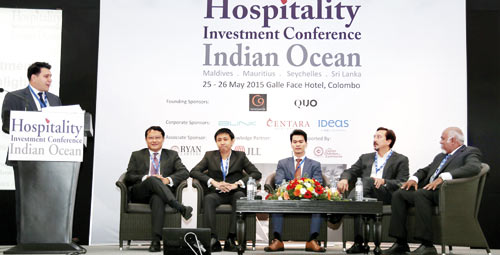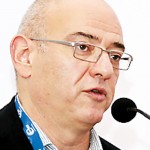Lanka’s tourism product under-priced, says branding specialist
Sri Lanka’s tourism product is under-priced and has the potential to grow exponentially but – like many island nations – needs to also redefine its brand, according to a tourism specialist.
“I would reckon the product (hotel rates) is under-priced by (I believe) at least 50 per cent because you have a value proposition that is very diverse and rich and can command a higher premium,” said David Keen, CEO of Quo, a hospitality branding specialist, speaking at the Hospitality Investment Conference Indian Ocean (HICIO) 2015” organized by Singapore-based SPHERE Conferences held in Colombo on May 25-26.
The meeting that covered island nations – Sri Lanka, the Maldives, Mauritius and the Seychelles brought together close to 100 industry professionals from nine different countries.

Panel discussion
Presenting a branding strategy for ‘tourist’ islands, Mr. Keen said one of the problems that Sri Lanka has is in harking back to the past on war, conflict and economic issues (in its marketing proposition).
“You need to move forward. Sri Lanka Tourism needs to redefine the brand proposition of Sri Lanka with all its diversity, richness, colour and natural beauty,” he asserted.
The branding expert, presenting a case for a new branding proposition for not only Sri Lanka but other island nations promoting tourism in the Indian Ocean, said there is much more in the country than what is promoted (beaches, sands, culture which are what tour agents talk about). “Sri Lanka has such a breadth of diversity but the ‘Wonder of Asia’ doesn’t talk about the incredible offerings like kids going to school, devotees in temples, churches, chatter on the streets, lifestyles, cooking a curry,” he said, showing slides from a standard Sri Lankan presentation which showed sun, sand, beaches, wild life and Sigiriya.
His comments tallied with those made by a Singapore hospitality expert who told a Colombo meeting some months ago that when she asked for a package tour of Sri Lanka, the offering was similar to that experienced 10-15 years ago. “It was no different. I have been visiting Sri Lanka for

David Keen
many years and the package was the same as 10-15 years ago. You need to change your product, you need to provide experiences,” she had said.
Quo CEO Mr. Keen, reflecting the same thoughts said today’s – what he calls – New Age Traveller (NAT) has different needs and looks for experiences, not only traditional offerings.
He suggested that the country brand should come from the people and be for the people … not branded for the world, citing the example of New Zealand which is a pure New Zealand brand.
A New Zealand tourism promotional video on YouTube titled “Haere Mai – Welcome to 100% Pure New Zealand” shows children from the “youngest country on earth’ doing the ‘Haka” – the traditional war dance in a rugger match and shouting the ubiquitous ‘haka’ cry, a visitor hugging a giant tree, people walking through parks, beautiful mountains, all to the strains of a Maori song.
Mr. Keen also praised the Kerala “God’s only Country” brand and admired the local, indigenous ‘Cinnamon’ chain from John Keells saying “Cinnamon is a super, local brand.”
Brands, he said must have a definition. They should be more than just white sand, romance, underwater fish and heritage sites. Brands are about people, colour, stories and experiences.
Emphasising that there is a fundamental shift in the consumer landscape with an increasing number of Asian travellers compared to European travellers and also the NAT, Mr. Keen said Europeans prefer to detach themselves (from the outside world while travelling), take more trips within their continent, travel less but for longer periods and want to relax for longer breaks.
Asian travellers on the other hand are more likely to venture beyond their continent; travel more but for shorter periods and want to stay connected through social media and mobile phone throughout the trip.
“Despite these fundamental shifts, images portrayed of these (island) destinations haven’t changed over the years. There is so much more in these countries than what their tourism boards portray,” he said, explaining as one example that sometimes chairs on a verandah outside a hotel room may work for the European traveller but not the Asian (NAT) traveller implying that the Asian visitor is always online and is unlikely to always sit in a verandah enjoying the waves and the ocean.
At least in two island destinations – Sri Lanka and the Maldives – the Asian traveller has overtaken the European visitor but the hotels and resorts are still modelled and cater to the latter segment.
| Aitken Spence building two new properties in the Maldives The Aitken Spence Hotels group is expanding its footprint in the Maldives with the acquisition of two new properties, making it the largest foreign hotel operator there. A company announcement on Monday said that it has invested US$5 million in leasing the Raafushi Island in Noonu Atoll for a new resort with 4- star status. The number of rooms is yet to be decided. A senior company official said the group is also investing $50 million in an upmarket 5-star property in uninhabited Aaarah Island on Raa Atoll with 163 rooms inclusive of water bungalows and villas. The group already operates resorts in Meedhupparu (two resorts), Hudhuranfushi, Rannalhi and Vadoo in the Maldives. It has a total of 24 hotels and resorts in four countries – Sri Lanka, Maldives, India and Oman—with a room inventory of over 2000 rooms in the 3-5 star category. “We now have 600 rooms in the Maldives and the two new properties will raise it to 900-950 rooms. That would make us the largest foreign hotel operator in the Maldives,” the official said. Maldives hotelier aiming to create the country’s largest resort Sun Siyam, a Maldives indigenous hospitality brand, is building the island nation’s largest resort with 600 rooms and expanding its base in neighbouring Sri Lanka with a second resort, its owner and founder said. Ahmed Siyam Mohamed, Chairman and Managing Director of Sun Siyam divulging these plans at the Colombo hospitality conference, said the project on Dhigurah Island is his most challenging and ambitious project yet. “The resort with 14 different room categories, no fewer than 15 F&B outlets, family-friendly accommodations and an underwater restaurant and wine cellar is evidence that the country is on the verge of a massive repositioning,” he was quoted as saying.He said he was also expanding in Sri Lanka to two properties after Sun Aqua Pasikudah with Sun Siyam at Kalpitiya with water villas. |


